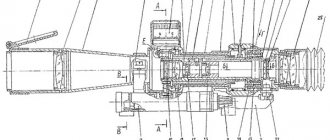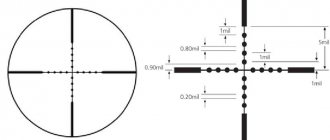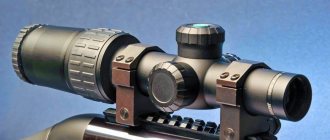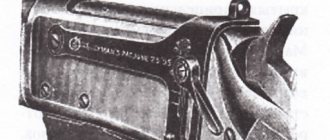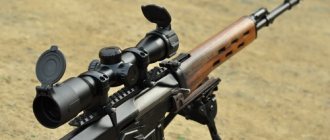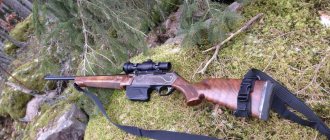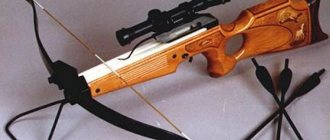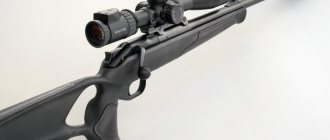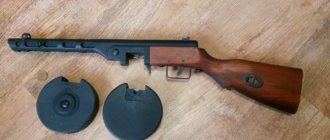An optical sight is an optical device consisting of a set of lenses combined in a special way, placed in a metal tube and designed to accurately aim a weapon at a target. An optical sight has long ceased to be a rarity; it is difficult to imagine a modern hunting rifle without an optical sight installed on it.
What types of optical sights are there? How to choose an optical sight? What parameters should you pay attention to when choosing? Let's look at these questions and answer them in detail.
Story
The predecessors of the optical sight are the telescope and spotting scope, which were invented in Holland at the beginning of the 17th century.
The world's first optical sight was invented in 1745 by Russian mechanical engineer A.K. Nartov, who was working at the Admiralty Department at that time. He called his invention “A mathematical instrument with a perspective telescope, with other accessories and a spirit level for quick guidance from a battery or from the ground at the shown location to the target horizontally and along the levation.”
Since the 1860s, rifle telescopes, as optical sights were called at that time, began to be widely used on hunting rifles. Optical sights were first used for military purposes in 1861-1865, during the American Civil War.
The modern type of optical sight as we know it today was created in 1880 in Austria-Hungary by August Fiedler.
The first variable magnification sight was created in 1949 by Frederic Kales. In 1972, she developed and patented multilayer coating for optics.
Optical sights are constantly being improved; more and more new materials and technologies are used in their design and production, new functions appear, and capabilities are expanded.
Which scope is better - constant or variable magnification?
In other words: “Which scope is better, constant or variable (changeable) magnification?”
Here it is worth answering that there is no “best” scope at all. Everywhere has its own advantages and disadvantages. Something more, something less will suit you.
Advantages of fixed magnification sights:
- Easy to use.
- Somewhat greater strength and reliability.
- A well-designed sight is quite comfortable and provides a good field of view.
- Great for beginner shooters.
- Well suited for recreational bottle shooting and small game hunting.
Features of variable magnification sights:
- The ability to customize makes this sight suitable for different tasks and conditions.
- It makes it possible to both view a distant target and get a bright picture with a wide field of view for assessing the situation and aiming at short distances.
- At the same time, such a sight is more demanding of the shooter’s knowledge and skills. Understanding the process of setting up and adjusting the sight. Ability to correctly estimate distances and make corrections at different distances.
Optical sight device
Lens
The lens of an optical sight is a system of two or more lenses. The outer surface of the lens entrance lens most often has an anti-reflective coating, which prevents the back reflection of light and increases the aperture of the sight. The purpose of the lens is to collect as much light as possible and transmit it further.
Three parameters characterize the quality of the lens of an optical sight: the larger the diameter of the lens, the better the quality of the glass of the lenses and the better the quality of the anti-reflective coating of the lenses, the greater the aperture of the optical sight, the brighter its image, the better it is visible through the sight in the twilight, at night and when there is insufficient daylighting.
On some scopes, a light-protective hood or anti-reflective attachment is placed on the lens, which is sometimes necessary to prevent side rays from entering and then being reflected from the lens. The lens hood allows you to disguise the location of the shooter and improves image clarity in bright sunshine.
Wrapping system
The lens of an optical sight produces an inverted image; a wraparound lens system produces a correct, non-inverted image at the output. A high-quality sight uses more than 10 converging and diverging lenses, which are combined into groups.
The wrapping system is one of such groups. It is important that the lenses of the optical sight are securely fixed in the sight body and can withstand the recoil of weapons of any caliber.
Reticle
The aiming reticle is designed to aim the weapon at the target. The reticle can be located in one of the focal planes of the sight, objective or ocular. The reticle can have a different pattern, most often it has the shape of a cross or half-cross, but there are also more complex types. Some types of aiming reticles are designed in such a way that they allow you to calculate, with greater or less accuracy, the distance to the target based on its known dimensions.
Illuminated reticle
The reticle may be difficult to see in poor lighting conditions, at night, at dusk, or against dark vegetation. In order to solve this problem, a reticle illumination is built into the sight.
Mechanism for entering vertical and horizontal corrections
A mechanism for entering vertical and horizontal corrections is needed to zero the weapon and align the aiming reticle with the point of impact. The sight has two adjustment drums: one moves the reticle vertically, the second horizontally. The drums have a scale on them, and the drums rotate with clicks. The angle by which the reticle moves in one click is indicated in the technical specifications of the sight.
Sight body
Optical sight bodies are made of lightweight but very durable alloys. The body connects all components of the sight into a single structure.
The housing protects the internal parts of the sight from moisture and dust, and also protects them from powerful shock loads that occur during shooting.
Eyepiece
The eyepiece of an optical sight is a group of several lenses. It is the eyepiece of the optical sight that is responsible for magnifying the image of the target and the reticle. The focal length of optical sights designed for installation on rifles and carbines is usually 50-70 mm. This is exactly the distance from which you need to look through the scope in order for the image in the scope to be clear and not darkened at the edges. To adjust the sight to the shooter’s individual vision characteristics, there is a special rotating diopter ring on the eyepiece.
Some sights have a special rubber eyecup that fits over the eyepiece of the sight, which is needed in order to fix the eye in one position at the sight, as well as to avoid glare and flare on the eyepiece lens.
Features of hunting scopes
For anyone, not necessarily a novice hunter, choosing the right scope is extremely important.
The selection of a scope is carried out taking into account many circumstances, so you should approach this important event with the utmost caution. Experts recommend that you first familiarize yourself with the existing types of sighting devices for hunting. However, it is still advisable to select a small scope in order to have time to fire the long-awaited shot in a timely manner in the event of a sudden face-to-face collision with a wild animal or game.
A variety of hunting scopes
Hunting scopes mainly come in the following varieties:
- Optical;
- Collimator;
- Laser;
- Night vision.
All of the above types of hunting scopes have their advantages and disadvantages, as well as operating features and a wide variety of effectiveness, but in general they all meet the same characteristics as shooting scopes.
Advantages of optical sights
- The optical sight increases the size of the target, which allows you to fire shots with high accuracy and at a long distance
- The target image and the aiming reticle are on the same plane, at the same distance from the eye, the shooter does not need to constantly refocus his gaze from the front sight to the target and back, which increases the convenience of aiming and reduces eye fatigue
- Many optical sights allow you to determine the angular dimensions of a target and calculate the distance to it
- The optical sight collects more light than the human eye, allowing you to see the target better in low light conditions
- Optical sights with an illuminated aiming reticle allow you to see it against a dark background, thereby making it possible to fire a shot in poor lighting conditions, up to almost complete darkness.
- The optical sight allows accurate shooting for people with visual impairments, including people with myopia, farsightedness and astigmatism, compensating them for their lack of vision
How to properly zero an optic on a pneumatic rifle?
Zeroing in the sight begins at a distance of 50 meters. Before zeroing, it is necessary to align the mechanical and optical axis of the sight. To do this, the correction handwheels are set to zero, but not those marked on the dials, but the true ones. True zero is obtained as follows: by rotating the drum from stop to stop, you need to count the number of clicks, half of their number will be true zero.
The first shots will most likely end up completely different from where you expected them to be. It doesn’t matter, by making adjustments using the handwheels, achieve hits in the center of the target. The same must be done for a distance of 100 meters. You should not make adjustments after each shot; usually they shoot in series of 3 shots and adjustments are made by assessing the results of the series.
There is an easier way. A rifle is fired at the center of the target, then the reticle crosshairs are aimed at the point of impact. While holding the rifle motionless, the adjustment wheels move the crosshair to the center of the target.
You can learn more in the article “How to zero an air rifle”
Disadvantages of optical sights
- The optical sight greatly reduces the field of view, thereby making it difficult to find a target and making it almost impossible to shoot at fast-moving targets
- The optical sight makes it very difficult to shoot at close range (20-30 meters), the target looks too big in the sight, blurry and shakes a lot, all this makes aiming much more difficult
- Trembling hands and movement of the chest when the shooter breathes can significantly complicate aiming with a weapon equipped with an optical sight.
Characteristics of optical sights
Objective lens entrance diameter
The diameter of the lens is one of the most important parameters of an optical sight, which affects the aperture ratio. The larger the diameter of the lens, the more light it collects, the greater the aperture of the scope, and the brighter and lighter the image produced by such a scope will be. The diameter of the lens will be especially important if the scope is used for hunting in low light conditions, at dusk or at night.
The choice of scope lens diameter depends on hunting conditions. For daytime hunting, a lens with a diameter of 40 mm is sufficient. For hunting at dusk, the best choice would be an optical sight with a lens diameter of 56 mm.
When choosing the lens diameter, it should be taken into account that as the lens diameter increases, the total weight of the sight also increases.
Lens quality and anti-reflective coatings
The image quality provided by a scope greatly depends on the quality of the glass lenses used in the scope and on the presence and quality of the anti-reflective coating on the lenses.
An objective lens with an anti-reflective coating applied to it transmits light much better, due to this the sight lens produces a more contrasting, bright and light image. From the outside of the lens, a lens that has an anti-reflection coating may appear orange, green, blue or purple, depending on the materials used to make the anti-reflective coating.
Anti-reflective coating on sight lenses can be of three types:
- C (Coated) - simple single-layer lens coating
- MC (Multi Coated) - multi-layer coating, but not on all lens surfaces
- FMC (Fully Multi-Coated) - multi-layer coating on all lens surfaces
Sights with FMC (Fully Multi-Coated) lenses provide a significantly brighter and more contrasty image compared to scopes with other types of lens coatings.
Increase
A group of lenses located in the eyepiece of the sight are responsible for magnifying the sight; they magnify and project the image onto the retina of the shooter’s eye.
Based on the type of magnification, all optical sights are divided into two groups: sights with constant magnification and sights with variable magnification.
Constant magnification sights
Sights with constant magnification have the following properties:
- All eyepiece lenses are rigidly fixed
- They have a higher aperture ratio because they have fewer lenses, so they give a brighter image
- They have greater reliability, since they have no moving elements
Variable sights
multiplicity
Sights with variable magnification have the following properties:
- Contains a movable lens in the eyepiece, with the help of which the magnification of the sight is adjusted
- They have a lower aperture ratio, since they contain a larger number of lenses, they give a darker image, in order to correct this shortcoming they have to use higher quality lenses
- Allows, along with changing the magnification, to change the angle of view of the sight
It is up to the hunter to decide which scope to choose with constant or variable magnification. If you know in advance exactly under what conditions and at what distance the shooting will be carried out, sights with constant magnification are preferable. If it is not known in advance under what conditions and at what distances the shooting will take place, then sights with variable magnification are preferable, since they are more universal.
- For shooting at short distances, at moving targets, for example during driven hunting, sights with a small magnification, no more than 1.5-2, are very convenient. They have a wide angle of view, thanks to which you can shoot with them even offhand, without careful aiming, with both eyes open.
- Sights with medium magnification are the most versatile and can be used for most types of hunting. The most versatile optical sights are those with variable magnification 3x–9x or 3x–12x.
- Sights with high magnification are designed for shooting at paper targets and for hunting at long and ultra-long distances. They have more weight, less aperture, and a small angle of view. They are used for special types of hunting; such sights cannot be considered universal. The most popular among them are scopes with variable magnification 6x–24x and 8x–32x.
Numbers in the name of the optical sight
Optical sights are usually marked in a special way. The scope is marked with two numbers separated by an “x”. For example: “Nikon Prostaff 4×32 optical sight.” The number 4 in the scope designation indicates the magnification of the scope, and the number 32 indicates the diameter of the objective lens entrance.
Sights with variable magnification are marked in a very similar way; first the magnification range is indicated, then the lens diameter. For example: “Leupold VXII 3-9×40 Riflescope,” which means a variable power scope with a magnification of 3x to 9x and a lens diameter of 40mm.
Exit pupil diameter
The diameter of the exit pupil is an important parameter of an optical sight, which indicates the size of the light beam emerging from the eyepiece. The larger the exit pupil diameter, the brighter and lighter the image produced by the scope. A large exit pupil diameter is especially important when hunting in low light conditions, twilight, at night, as well as when the shooter’s vision is imperfect.
In order to calculate the exit pupil diameter of a scope, you need to divide the lens diameter by the scope magnification, for example for a 4x32 scope, 32/4=8 mm.
The most optimal diameter of the sight's exit pupil is about 5 mm. The diameter of the exit pupil of the sight is more than 7-8 mm, larger than the diameter of the human pupil; there is no point in such a large diameter of the exit pupil.
Eye relief
The eye relief of an optical sight is the optimal distance between the sight eyepiece and the shooter's eye. For different optical sights, the eye relief can be from 40 to 105 mm. As this parameter increases, safety from recoil during a shot increases, but at the same time, along with an increase in eye relief, the convenience of aiming decreases.
The minimum allowable eye relief for the scope is 40 mm. When using a sight on a large-caliber rifled weapon - 60 mm, when using a sight on a smooth-bore weapon when shooting shotguns - at least 80 mm.
Sight field of view
When choosing an optical sight, you need to remember such a parameter as the field of view of the sight (Field Of View). The field of view of a sight is the width of the space viewed by the sight; it can be measured in degrees or in meters per 1 km. The greater the magnification (magnification) of the sight, the smaller the field of view.
This parameter is especially important when shooting at moving targets, when it is important that the target does not leave the field of view while aiming, therefore, when shooting at moving targets, the larger the field of view, the better. When shooting at stationary targets, this parameter does not play such an important role.
How to determine the purpose of a sight by its magnification?
1-4x
If a scope with such characteristics is equipped with a small-diameter lens, it turns out to be very light and compact. In other words, this is an excellent option for those who plan to walk a lot over rough terrain.
A large diameter lens mounted on such a scope will provide it with a very large field of view. Such a sight will be convenient for driven hunting, during which you often have to aim at suddenly appearing, fast-moving targets that are, as a rule, not at too great a distance. That’s why such sights are also called “driven” sights.
4-7x
The lens diameter is usually from 32 mm. Most often used for distances of 30-60 m. A universal option that is well suited for air rifles. There are designs that are strong enough to be compatible even with spring-piston rifles.
3-9x
One of the most common models.
Sights with magnification up to 9x are traditionally considered hunting. For the most part, they do not have the largest entrance lens diameter and are low in cost. It is also worth paying attention to the fact that for shooting at a moving target, it is advisable to use scopes with a magnification of up to 4x.
Athletes shoot at 80m and beyond. The most commonly used magnification is 8x. Other multiplicities for them are “just in case.” It is believed that these sights perform well at ranges up to 200 meters.
4-12x
Often used by air rifle shooters to shoot at paper. The most commonly used magnifications are 8-10x.
A magnification of 10x to 16x indicates that the scope is suitable for shooting at targets and small targets. When purchasing optics with this magnification, you should remember that in order for the picture to be bright, the lens must have a diameter of at least 40mm.
6-24x
Such sights are used for shooting at a distance of 300-500 m from rifles and carbines. They are also used by owners of high-power air pistols. They are also used for shooting at paper targets (with preliminary zeroing).
The lens diameter is most often 40-56 mm. The design is strong enough to withstand the recoil of serious calibers.
Although such scopes are usually quite expensive, there are now some pretty decent options available at an affordable price.
An important reminder to owners of dual-recoil spring-piston rifles.
The design features of your rifles are such that very often even high-quality optics are destroyed after firing about 100-200 shots. We recommend that you choose a durable constant magnification scope with a lens no larger than 32mm. The sight must be installed only on a monoblock bracket!
Reticles
The reticle is located in the optical sight between the lens and the eyepiece, it is used to aim the sight at the target. To aim, you need to combine the target image with a certain part of the aiming reticle (crosshair, stump, corner).
The reticle is either a metal stencil or, most often, a lens with a reticle pattern applied to it. Part of the reticle may be a rangefinder scale, with which the shooter can calculate the distance to the target, knowing its dimensions.
Before firing from a weapon with an optical sight, the sight must be zeroed; for this, special handwheels are used to move the aiming reticle so that, at a certain distance, it coincides with the middle point of impact.
The reticle can be located on an optical sight in two planes: in the front focal plane (lens plane) designated FFP and in the rear focal plane (eyepiece plane) designated SFP.
If the reticle is located in the front focal plane (FFP), then the image on it itself will be inverted, but if the reticle is located in the rear focal plane (SFP), then the image on the reticle will be upright.
If a scope with a variable magnification has a reticle located in the front focal plane (FFP), then as the magnification increases, both the size of the target and the reticle itself increase.
For a scope with variable magnification with a reticle located in the rear focal plane (SFP), as magnification increases, the target image increases, but the size of the reticle and the thickness of its threads do not increase and remain the same.
There are many types of reticles. Most reticles are universal, suitable for shooting in different conditions, with different cartridges, at different distances. Some manufacturers of optical sights develop and produce their own specific sighting reticles, designed to fire certain cartridges, marked with impact points at different distances, such reticles are called ballistic.
Let's look at some of the most common sighting reticles.
Reticle "Cross" (Duplex)
The most famous and popular type of reticle. Such an aiming reticle allows you to aim the weapon with high accuracy, even at a small or very distant target. There are two varieties of this mesh: classic, the threads of which have the same thickness, and improved, the threads of which are narrower near the crosshair itself. The improved version of the grid is much more convenient. With this reticle, you can measure the distance to the target using the angular distance from the crosshair to the thickening of the sight threads.
Sighting reticle “Stump” (German)
This type of reticle was popular many years ago, but nowadays its popularity has decreased significantly. The main advantage of this reticle is the ability to quickly aim the weapon at the target. Using the distance between the side lines, you can measure the distance to the target, knowing its size.
Sighting reticle "PSO-1"
It was first used on the Soviet optical sight PSO-1, and is now still used on many optical sights of domestic production.
The PSO-1 mesh is intended for military purposes; it is not suitable for hunting purposes, although many hunters use it. This aiming reticle allows you to point the weapon at a small and/or distant stationary target with high accuracy.
The reticle has a ranging scale that allows you to quickly determine the distance to a standing person. Additional sighting angles allow you to shoot at different distances without having to readjust your sight.
Mil-Dot reticle
The most popular sighting reticle among those who like to shoot from a wide variety of weapons at long distances, it allows you to point the weapon with high accuracy at a small and distant stationary target.
The Mil-Dot reticle consists of two coordinate axes with equidistant marks. The angular distance between the grid points is 1 mil, the size of the dot itself is 0.25 mil, and the angular distance between the edges of two dots is 0.75 mil. Knowing these distances, the shooter can determine the distance to a target with known dimensions.
Ballistic reticles
A whole group of sighting reticles have several aiming points designed for firing a specific cartridge at various standard distances. There are ballistic reticles that have additional side marks designed to compensate for wind drift of the bullet. Sights with ballistic reticles give the shooter an advantage in accuracy and speed of aiming.
The shooter, when choosing the reticle of his optical sight, must take into account what weapon the sight will be installed on, under what conditions, at what distances and at what targets the shooting will be conducted. For most hunters, the most convenient reticle will be the “LR Duplex” type, which has a crosshair with thinning towards the center.
Illuminated reticle
When hunting in poor visibility conditions, at dusk, at night, against a background of vegetation, thin threads of the reticles become difficult to see for the shooter. To eliminate this drawback, manufacturers of optical sights produce sights with an illuminated reticle.
In old military sights, the illumination of the aiming reticle was done according to the principle of the spiral of an incandescent lamp; in the dark, when the illumination was turned on, it glowed orange. In modern optical sights, the illumination of the aiming reticle is based on LEDs, which are powered by a small coin cell battery.
Most often, the illumination of the sighting reticle is made in red or green, less often blue. Many modern sights have several backlight colors and you can select it yourself using a switch. It is highly desirable that the scope has an adjustable backlight brightness, otherwise, in some hunting conditions, too bright illumination of the reticle may illuminate the target and become an obstacle to making an accurate shot.
Parallax
The target image in an optical sight is projected by the lens onto the plane where the aiming reticle is located; parallax is the discrepancy between the target image plane and the plane of the aiming reticle.
Depending on which plane the reticle is in, the parallax in these two types of sights will look different. With a front focal plane (FFP) scope, when you move your eye to the left or right relative to the eyepiece, the target image appears to float relative to the center of the reticle and the aiming point moves away from the target. With a rear focal plane (SFP) sight, parallax appears a little differently; when the eye moves left to right relative to the eyepiece, the reticle is blurred and the shooter cannot clearly see both the reticle and the target at the same time.
Some scopes have a fixed parallax adjustment at a certain distance, made at the factory, without the ability to change it later. Other sights, more expensive, often with higher magnification, have a special mechanism for adjusting parallax depending on the shooting distance; for this, either the entire group of objective lenses or only the back part of the lenses, located closer to the aiming reticle, moves in the sight.
There are two parallax adjustment systems for optical sights:
- AO (Adjustable Objective)
- the parallax adjustment ring is located on the lens of the sight; the focusing distance scale in yards or meters is printed on the ring. This system is more common because it is simple and cheap. The disadvantage of such a system is the impossibility of adjusting parallax without looking away from the target. - SF (Side Focusing)
- a special regulator is located on the side of the sight; you can adjust the parallax without changing the position of the body and head and without looking up from the target.
Amendment mechanism
Any optical sight, after installing it on a weapon, requires zeroing. Zeroing the sight is necessary so that the center of the reticle coincides with the midpoint of impact. For this purpose, any sight has special handwheels, which are also called drums or turrets. One of the drums regulates the vertical movement of the sighting reticle, the other drum adjusts the horizontal movement of the sighting reticle.
Reels on optical sights can be of two types: hunting and tactical.
Hunting drum sights have a screw-on cover, under which the rotating drum itself is hidden. The cover is unscrewed only when the sight is zeroed; after the sight is zeroed, the lid is screwed on. During hunting, no adjustments are made to the sight.
Tactical drums are designed in such a way that they can be tightened at any time. Immediately before the shot, the shooter can make the necessary adjustments, depending on the distance of the shot, the speed and direction of the wind.
The optical sight correction mechanism must have the following mandatory qualities:
- The adjustment mechanism of the optical sight must have a large range of vertical adjustments; it must be at least 45-50 minutes of arc (MOA). This range of adjustments allows shooting at long distances.
- The adjustment mechanism of the optical sight must ensure strict perpendicularity of the settings, that is, when adjusting the sight vertically, there should be no deviation to the side.
- The mechanism of the optical sight must ensure repeatability of corrections, that is, when adjusting the correction drum in the forward and reverse directions by the same number of clicks, the reticle point of the sight must point to one point.
Gas filling
The housings of high-quality optical sights are completely sealed and filled from the inside with an inert gas, most often nitrogen. The lenses of the sight filled with nitrogen do not fog up due to temperature changes. This property of the scope is especially important when hunting in difficult weather conditions, with high humidity and low temperatures.
Installing a sight on a weapon
Many carbines and rifles have a ready-made Weaver/Picatinny rail, or dovetail mount, on the receiver. Other carbines and rifles have a mounting seat with threaded holes that accept either scope rings or a Weaver/Picatinny or dovetail adapter.
Scope rings can be of two types: with a diameter of 25.4 mm and 30 mm. The appropriate type of rings is selected depending on the diameter of the scope tube. The rings also vary in height. The height of the sight rings is selected depending on the diameter of the sight lens: the larger the lens diameter, the greater the height of the rings should be.
Rings can also be in the form of two separate rings, or in the form of a monoblock. It is recommended to install rings in the form of a monoblock on weapons with strong recoil.
Some examples of domestically produced hunting weapons with a military background may require the installation of a sight on the side, on a special bracket.
Technical parameters of hunting optics
Hunting optical sights have different technical sizes, from 270 mm. up to 350 mm. and more. Optics with dimensions over 350 mm, designed for shooting at a distance of over 700 meters, are most likely least suitable for regular hunting.
Mechanism for adjusting horizontal and vertical adjustments:
In order to adjust the reticle, any optical sight has lateral and vertical adjustments, with the help of which the reticle in the eyepiece moves. This setting is very convenient, because at a certain distance you can adjust the sight in such a way that you can always hit without missing. Variable magnification optics also have such a mechanism for adjusting the corrections, but it also has an approach and distance adjustment, which makes it possible to accurately hit both at a relatively close distance and at a long distance.
Optical housing and some differences
All sights have a body made of durable, lightweight aluminum alloy, usually black. At the moment, choosing a relatively inexpensive and good scope so that it meets all your needs is quite difficult. Thus, inexpensive optics with variable magnification are less reliable than optics with constant magnification at the same cost: the difference lies in the design itself, because making internal lenses movable is much more difficult than simply fixing them motionless in the body. Again, expensive optics with high variable magnification may not live up to high expectations, since you need to have confident shooting skills, with calculations and adjustments such as wind, range, weather conditions, bullet speed, etc. All this will be difficult for a beginner hunter Models of optical sights from well-known manufacturers usually have anti-reflective films installed and may have a built-in laser rangefinder, which is simple and useful to use.
